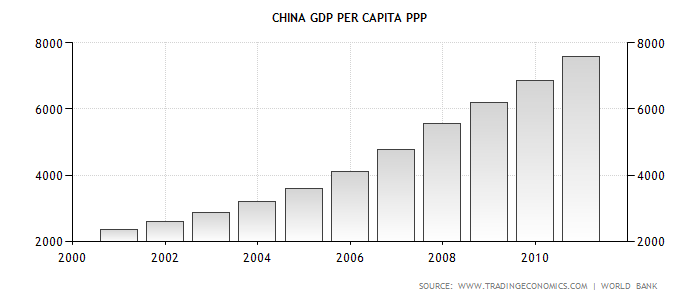
China GDP per capita PPP: 7,598 USD in 2010
The GDP per capita, adjusted by purchasing power parity, in China was last reported at 7599 US dollars in December of 2010, according to the World Bank.
China GDP per capita PPP:
9,800 USD in 2013
9,200 USD in 2012
8,600 USD in 2011
7,598 USD in 2010
6,863 USD in 2009
United States: $ 16,720,000,000,000
China: $ 13,370,000,000,000
Previously, the GDP per capita PPP in China standed at 6863 US dollars in December of 2009. The GDP per capita PPP in China is obtained by dividing the country’s gross domestic product, adjusted by purchasing power parity, by the total population. Historically, from 1980 until 2010, China’s average GDP per capita PPP was 2221.51 dollars reaching an historical high of 7598.84 dollars in December of 2010 and a record low of 249.94 dollars in December of 1980. This page includes a chart with historical data for China’s GDP per capita PPP.
About GDP Per Capita Adjusted by Purchasing Power parity
The GDP dollar estimates given on this page are derived from purchasing power parity (PPP) calculations. Using a PPP basis is arguably more useful when comparing generalized differences in living standards on the whole between nations because PPP takes into account the relative cost of living and the inflation rates of the countries, rather than using just exchange rates which may distort the real differences in income. However, economies do self-adjust to currency changes over time, and technology intensive and luxury goods, raw materials and energy prices are mostly unaffected by difference in currency (the latter more by subsidies), despite being critical to national development, therefore, the sales of foreign apparel or gasoline per liter in China is more accurately measured by the nominal figure, but everyday food and haircuts by PPP. The gross domestic product per capita is the value of all final goods and services produced within a nation in a given year divided by the average (or mid-year) population for the same year. The gross domestic product (GDP) is one of the measures of national income and output for a given country’s economy. GDP can be defined in three ways, all of which are conceptually identical. First, it is equal to the total expenditures for all final goods and services produced within the country in a stipulated period of time (usually a 365-day year). Second, it is equal to the sum of the value added at every stage of production (the intermediate stages) by all the industries within a country, plus taxes less subsidies on products, in the period. Third, it is equal to the sum of the income generated by production in the country in the period—that is, compensation of employees, taxes on production and imports less subsidies, and gross operating surplus (or profits).

Leave a Reply